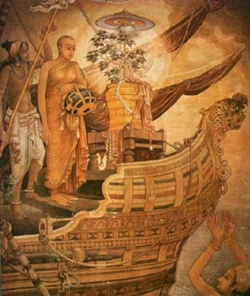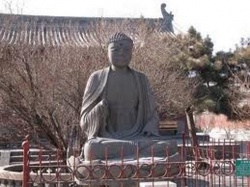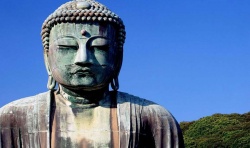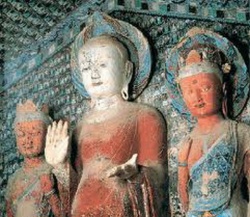Difference between revisions of "Yogacara Philosophy"
| Line 3: | Line 3: | ||
Three Important [[Mahayana Sutras]] That Led to [[Yogacara]] [[Philosophy]] | Three Important [[Mahayana Sutras]] That Led to [[Yogacara]] [[Philosophy]] | ||
| − | 1. Samdhinirmocana ("Freeing the Underlying Meaning"): This text [[views]] itself as a third "turning of the [[Dharma]] [[Wheel]]" that surpasses even the first two (The [[Four Truths]] and [[Perfection]] of [[Wisdom]] [[Sutra]]). | + | 1. [[Samdhinirmocana]] ("Freeing the Underlying Meaning"): This text [[views]] itself as a third "turning of the [[Dharma]] [[Wheel]]" that surpasses even the first two (The [[Four Truths]] and [[Perfection]] of [[Wisdom]] [[Sutra]]). |
2. The [[Mahayana]]-[[abhidharma]] [[Sutra]]. | 2. The [[Mahayana]]-[[abhidharma]] [[Sutra]]. | ||
| Line 13: | Line 13: | ||
II. The [[Yogacara]] Orientation | II. The [[Yogacara]] Orientation | ||
| − | A. [[Yogacara]] means "the practice of [[Yoga]]" referring to the [[Bodhisattva's]] [[path]] of [[meditative]] development. [[Yogacarin]] theories are [[rooted]] in the practice of [[dhyana]] ([[meditation]]). | + | A. [[Yogacara]] means "the practice of [[Yoga]]" referring to the [[Bodhisattva's]] [[path]] of [[meditative]] [[development]]. [[Yogacarin]] theories are [[rooted]] in the practice of [[dhyana]] ([[meditation]]). |
[[File:Bhikkhuni Sanghamitta.jpg|thumb|250px|]] | [[File:Bhikkhuni Sanghamitta.jpg|thumb|250px|]] | ||
| − | B. Both Madyamaka and [[Yogacara]] have [[Buddhahood]] as the goal but the former emphasized [[prajna]] ([[wisdom]]), while the latter emphasized [[samadhi]] ([[meditation]]). [[Thus]], the schools may be [[thought]] of as complementary. | + | B. Both [[Madyamaka]] and [[Yogacara]] have [[Buddhahood]] as the goal but the former emphasized [[prajna]] ([[wisdom]]), while the [[latter]] emphasized [[samadhi]] ([[meditation]]). [[Thus]], the schools may be [[thought]] of as complementary. |
C. [[Buddhism]] generally seeks to transcend ordinary [[consciousness]] by [[seeing]] [[phenomena]] as [[impermanent]], unsatisfactory, and "[[no-self]]." [[Madhamaka]] similarly seeks the same goal by [[seeing]] all [[phenomena]] as [[empty]]. [[Yogacara]] emphasizes seeiing [[phenomena]] as [[mental]] constructions. | C. [[Buddhism]] generally seeks to transcend ordinary [[consciousness]] by [[seeing]] [[phenomena]] as [[impermanent]], unsatisfactory, and "[[no-self]]." [[Madhamaka]] similarly seeks the same goal by [[seeing]] all [[phenomena]] as [[empty]]. [[Yogacara]] emphasizes seeiing [[phenomena]] as [[mental]] constructions. | ||
| − | D. While [[Madhyamaka]] [[recognizes]] the normal [[experience]] of the [[world]] as built up by {{Wiki|conceptual}} constructions, they did not try to provide the [[psychological]] details of this process. [[Yogacara]] seeks to answer questions like, how are {{Wiki|memories}} and effects of {{Wiki|past}} [[karma]] transmitted over [[time]], if a [[being]] is composed of stream of momentary events (as described in the [[Abhidharma]]? The [[Yogacara]] school developed their own [[Abhidharma]] {{Wiki|literature}} to answer such questions, building on suggestions of earlier schools (e.g., the [[idea]] of [[karmic]] [[seeds]] which reproduce themselves over [[time]]). | + | D. While [[Madhyamaka]] [[recognizes]] the normal [[experience]] of the [[world]] as built up by {{Wiki|conceptual}} constructions, they did not try to provide the [[psychological]] details of this process. [[Yogacara]] seeks to answer questions like, how are {{Wiki|memories}} and effects of {{Wiki|past}} [[karma]] transmitted over [[time]], if a [[being]] is composed of {{Wiki|stream}} of momentary events (as described in the [[Abhidharma]]? The [[Yogacara]] school developed their [[own]] [[Abhidharma]] {{Wiki|literature}} to answer such questions, building on suggestions of earlier schools (e.g., the [[idea]] of [[karmic]] [[seeds]] which reproduce themselves over [[time]]). |
E. [[Yogacara]] emphasizes the role of [[consciousness]] for three classic [[Buddhist]] [[reasons]]: | E. [[Yogacara]] emphasizes the role of [[consciousness]] for three classic [[Buddhist]] [[reasons]]: | ||
| Line 25: | Line 25: | ||
1. [[Consciousness]] is the crucial link between [[rebirths]]. | 1. [[Consciousness]] is the crucial link between [[rebirths]]. | ||
[[File:Huayan-Mona244.jpeg|thumb|250px|]] | [[File:Huayan-Mona244.jpeg|thumb|250px|]] | ||
| − | 2. A [[transformed]] state of [[consciousness]] is associated with [[nirvana]]. | + | 2. A [[transformed]] [[state]] of [[consciousness]] is associated with [[nirvana]]. |
| − | 3. The perceiving [[mind]] is that which interprets [[experience]] so as to construct a [[world]]. | + | 3. The perceiving [[mind]] is that which interprets [[experience]] so as [[to construct]] a [[world]]. |
F. [[Yogacara]] ultimately rejects the [[reality]] of an extra-mental [[reality]]. | F. [[Yogacara]] ultimately rejects the [[reality]] of an extra-mental [[reality]]. | ||
| Line 33: | Line 33: | ||
III. The [[Yogacara]] [[View]] of the Role and [[Nature]] of [[Consciousness]] | III. The [[Yogacara]] [[View]] of the Role and [[Nature]] of [[Consciousness]] | ||
| − | A. In addition to 6 [[senses]] of [[early Buddhism]] ([[eye]], {{Wiki|ear}}, {{Wiki|nose}}, {{Wiki|tongue}}, [[body]], [[mind]]), [[Yogacara]] adds two: [[manas]] (a kind of subliminal [[consciousness]]) and the [[alaya]] ( a kind of non-conscious [[mind]]); this is the "[[storehouse consciousness]]." | + | A. In addition to 6 [[senses]] of [[early Buddhism]] ([[eye]], {{Wiki|ear}}, {{Wiki|nose}}, {{Wiki|tongue}}, [[body]], [[mind]]), [[Yogacara]] adds two: [[manas]] (a kind of {{Wiki|subliminal}} [[consciousness]]) and the [[alaya]] ( a kind of non-conscious [[mind]]); this is the "[[storehouse consciousness]]." |
B. The role of the [[Alaya-consciousness]]: when a [[person]] performs an [[action]], [[karmic]] traces are left in the [[alaya]]. These traces are "[[seeds]]" that reproduce over [[time]]. {{Wiki|Memories}} also are stored here as [[seeds]]. The result is a continuity of [[consciousnness]] and [[personality]] over [[time]] and beyond [[death]] into new [[births]]. The [[alaya]] also preserves the continuity of [[consciousness]] during nonconscious states such as [[sleep]]. | B. The role of the [[Alaya-consciousness]]: when a [[person]] performs an [[action]], [[karmic]] traces are left in the [[alaya]]. These traces are "[[seeds]]" that reproduce over [[time]]. {{Wiki|Memories}} also are stored here as [[seeds]]. The result is a continuity of [[consciousnness]] and [[personality]] over [[time]] and beyond [[death]] into new [[births]]. The [[alaya]] also preserves the continuity of [[consciousness]] during nonconscious states such as [[sleep]]. | ||
| Line 41: | Line 41: | ||
D. All [[forms]] of {{Wiki|individual}} [[consciousness]] (the [[six sense]] fields plus [[manas]] -- see A above) are {{Wiki|projected}} from the [[alaya]]. This "projection" is thus determined by our {{Wiki|past}} [[karma]] that helps [[shape]] our [[consciousness]] and is {{Wiki|equivalent}} to our "construction" of the [[world]]. | D. All [[forms]] of {{Wiki|individual}} [[consciousness]] (the [[six sense]] fields plus [[manas]] -- see A above) are {{Wiki|projected}} from the [[alaya]]. This "projection" is thus determined by our {{Wiki|past}} [[karma]] that helps [[shape]] our [[consciousness]] and is {{Wiki|equivalent}} to our "construction" of the [[world]]. | ||
| − | E. Mechanics of "world-construction": Within the [[alaya]], [[karmic]] [[seeds]] are matured through [[attachments]] to [[mental]] constructions. The [[seeds]] then ripen in the flow of [[mental]] [[experience]] (6 fields + [[manas]]). The flow of [[experience]] is split (by [[manas]]) into [[subject]] and [[object]] (an [[illusory]] distinction reinforced by [[language]]. The [[subject]] is taken to be real [[permanent]] "I." This "I [[delusion]]" [[causes]] [[attachment]] and more planting of [[karmic]] [[seeds]] leading to [[rebirth]]. | + | E. Mechanics of "world-construction": Within the [[alaya]], [[karmic]] [[seeds]] are matured through [[attachments]] to [[mental]] constructions. The [[seeds]] then ripen in the flow of [[mental]] [[experience]] (6 fields + [[manas]]). The flow of [[experience]] is split (by [[manas]]) into [[subject]] and [[object]] (an [[illusory]] {{Wiki|distinction}} reinforced by [[language]]. The [[subject]] is taken to be real [[permanent]] "I." This "I [[delusion]]" [[causes]] [[attachment]] and more planting of [[karmic]] [[seeds]] leading to [[rebirth]]. |
IV. The [[World]] As "[[Thought]] Only" (Compare to {{Wiki|Berkeley}}). | IV. The [[World]] As "[[Thought]] Only" (Compare to {{Wiki|Berkeley}}). | ||
| Line 49: | Line 49: | ||
B. The [[view]] is supported by various [[meditative]] [[experiences]] and [[dream]] [[experiences]] (i.e., you [[experience]] [[objects]] clearly in such states, but no-one is tempted to identify the [[objects]] of your [[experience]] with extra-mental [[realities]]. [[Yogacara]] explicitly denies that it follows that we [[live]] in private [[mental]] [[worlds]] -- different [[mental]] {{Wiki|representations}} can interact. | B. The [[view]] is supported by various [[meditative]] [[experiences]] and [[dream]] [[experiences]] (i.e., you [[experience]] [[objects]] clearly in such states, but no-one is tempted to identify the [[objects]] of your [[experience]] with extra-mental [[realities]]. [[Yogacara]] explicitly denies that it follows that we [[live]] in private [[mental]] [[worlds]] -- different [[mental]] {{Wiki|representations}} can interact. | ||
| − | V. The [[Three Natures]] (Compare to Plato's Divided Line and {{Wiki|Cave}} Allegories). | + | V. The [[Three Natures]] (Compare to [[Plato's]] Divided Line and {{Wiki|Cave}} Allegories). |
A. [[Constructed]] or [[Imagined]] [[Nature]] ([[parikalpita]]). Ordinary [[experience]]. | A. [[Constructed]] or [[Imagined]] [[Nature]] ([[parikalpita]]). Ordinary [[experience]]. | ||
| Line 55: | Line 55: | ||
B. Other Dependent ([[paratantra]]). This is the [[realm]] of [[relative]] [[knowledge]]. It comprehends that [[phenomena]] are [[interdependent]] and [[impermanent]]. | B. Other Dependent ([[paratantra]]). This is the [[realm]] of [[relative]] [[knowledge]]. It comprehends that [[phenomena]] are [[interdependent]] and [[impermanent]]. | ||
| − | C. Absolutely Accomplished ([[parinispanna]]). Absolutely real level. No subject/object distinction. This [[knowledge]] consists in the direct [[awareness]] of the [[emptiness]] of all [[phenomena]]. It is called "[[thusness]]." [[Emptiness]] is seen as positively [[existing]] (in contrast to [[Madhyamaka]]) but is {{Wiki|ineffable}} and known only by [[Buddhas]]. | + | C. Absolutely Accomplished ([[parinispanna]]). Absolutely real level. No subject/object {{Wiki|distinction}}. This [[knowledge]] consists in the direct [[awareness]] of the [[emptiness]] of all [[phenomena]]. It is called "[[thusness]]." [[Emptiness]] is seen as positively [[existing]] (in contrast to [[Madhyamaka]]) but is {{Wiki|ineffable}} and known only by [[Buddhas]]. |
VI. The [[Yogacara]] [[Path]] and Goal | VI. The [[Yogacara]] [[Path]] and Goal | ||
Latest revision as of 20:56, 23 November 2020
Three Important Mahayana Sutras That Led to Yogacara Philosophy
1. Samdhinirmocana ("Freeing the Underlying Meaning"): This text views itself as a third "turning of the Dharma Wheel" that surpasses even the first two (The Four Truths and Perfection of Wisdom Sutra).
2. The Mahayana-abhidharma Sutra.
3. Lankavatara (Descent into Lanka) Sutra.
B. Yogacara was founded as a separate school by Asanga (4th or 5th century). He wrote several works, some of which Chinese and Tibetan Buddhists attributed to the Celestial Bodhisattva, Maitreya (i.e., Maitreya inspired Asanga's works). Asanga converted his half brother Vasubandu who also wrote many important Yogacara treatise.
II. The Yogacara Orientation
A. Yogacara means "the practice of Yoga" referring to the Bodhisattva's path of meditative development. Yogacarin theories are rooted in the practice of dhyana (meditation).
B. Both Madyamaka and Yogacara have Buddhahood as the goal but the former emphasized prajna (wisdom), while the latter emphasized samadhi (meditation). Thus, the schools may be thought of as complementary.
C. Buddhism generally seeks to transcend ordinary consciousness by seeing phenomena as impermanent, unsatisfactory, and "no-self." Madhamaka similarly seeks the same goal by seeing all phenomena as empty. Yogacara emphasizes seeiing phenomena as mental constructions.
D. While Madhyamaka recognizes the normal experience of the world as built up by conceptual constructions, they did not try to provide the psychological details of this process. Yogacara seeks to answer questions like, how are memories and effects of past karma transmitted over time, if a being is composed of stream of momentary events (as described in the Abhidharma? The Yogacara school developed their own Abhidharma literature to answer such questions, building on suggestions of earlier schools (e.g., the idea of karmic seeds which reproduce themselves over time).
E. Yogacara emphasizes the role of consciousness for three classic Buddhist reasons:
1. Consciousness is the crucial link between rebirths.
2. A transformed state of consciousness is associated with nirvana.
3. The perceiving mind is that which interprets experience so as to construct a world.
F. Yogacara ultimately rejects the reality of an extra-mental reality.
III. The Yogacara View of the Role and Nature of Consciousness
A. In addition to 6 senses of early Buddhism (eye, ear, nose, tongue, body, mind), Yogacara adds two: manas (a kind of subliminal consciousness) and the alaya ( a kind of non-conscious mind); this is the "storehouse consciousness."
B. The role of the Alaya-consciousness: when a person performs an action, karmic traces are left in the alaya. These traces are "seeds" that reproduce over time. Memories also are stored here as seeds. The result is a continuity of consciousnness and personality over time and beyond death into new births. The alaya also preserves the continuity of consciousness during nonconscious states such as sleep.
C. The alaya consciousness also contains "pure" seeds, the source of religious striving. The deepest level of alaya consciousness goes beyond individuality to a universal reality "within" all beings.
D. All forms of individual consciousness (the six sense fields plus manas -- see A above) are projected from the alaya. This "projection" is thus determined by our past karma that helps shape our consciousness and is equivalent to our "construction" of the world.
E. Mechanics of "world-construction": Within the alaya, karmic seeds are matured through attachments to mental constructions. The seeds then ripen in the flow of mental experience (6 fields + manas). The flow of experience is split (by manas) into subject and object (an illusory distinction reinforced by language. The subject is taken to be real permanent "I." This "I delusion" causes attachment and more planting of karmic seeds leading to rebirth.
IV. The World As "Thought Only" (Compare to Berkeley).
A. The Yogacara philosophy is a form of philosophical Idealism, the thesis all that exist are minds and ideas. However, in Yogacara, the view is provisional and meant to develop a perspective that will facilitate enlightenment. We never experience the objects of the external world, and our experience is over-determined by our mental constructions.
B. The view is supported by various meditative experiences and dream experiences (i.e., you experience objects clearly in such states, but no-one is tempted to identify the objects of your experience with extra-mental realities. Yogacara explicitly denies that it follows that we live in private mental worlds -- different mental representations can interact.
V. The Three Natures (Compare to Plato's Divided Line and Cave Allegories).
A. Constructed or Imagined Nature (parikalpita). Ordinary experience.
B. Other Dependent (paratantra). This is the realm of relative knowledge. It comprehends that phenomena are interdependent and impermanent.
C. Absolutely Accomplished (parinispanna). Absolutely real level. No subject/object distinction. This knowledge consists in the direct awareness of the emptiness of all phenomena. It is called "thusness." Emptiness is seen as positively existing (in contrast to Madhyamaka) but is ineffable and known only by Buddhas.
VI. The Yogacara Path and Goal
A. To understand that the first two natures are the cause of defilements and suffering.
C. To overcoming dualistic contrast between subject and object through the process of calming meditation.
D. To attain the Dharma-realm, i.e., enlightenment through knowledge of inner nature. Thus, samsara is transfigured into nirvana.




